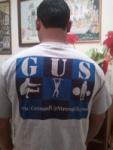|

08-02-2007, 01:03 PM
|
 |
Rank: Light Heavyweight
|
|
Join Date: Jul 2005
Location: Trinity University, San Antonio, Texas
Posts: 4,794
|
|

another thread..
Quote:
|
Originally Posted by aussiethrower
Throwing, Injury and Starting Strength
hi mark
firstly congrats on Starting Strength - its a great book. i am using it alot as i am coaching a few athletes in track and field. They are either just starting weight training or have been instructed with poor form. Your book has been a God send.
I also used your training protocol in Starting Strength for 12 weeks to rehab myself back to 70% of pre surgery strength ( I had knee surgery to realign my knee cap in Feb, i returned weight training at start of April). I have since moved on to my specific throwing training i followed before knee surgery. However I am still using your protocols for some exercises.
A few questions
1. I have a trainer who simply cant get into a squat position while holding the barbell correctly. It seems his shoulders and hips are very inflexible. Can you suggest any exercises that will help him get more flexible in these areas?
2. Can I use the clean or snatch high pull instead of the power clean for this individual?
3. Is it ok to add some single legged exercises to the Starting Strength program? or should i remove a squat session a week and add the single legged splits squats, lunges or bulgarian squats?
4. Would rotating Deadlifts, Snatch Grip Deadlifts and Trapbar deadlifts every 6 to 8 weeks still work with the Starting Strength Protocols?
5. My guys are coming up to an important competition at the end of October - would it be wise to deload a few weeks out, that said how to i do deload using the Starting Strength Protocols?
cheers
Wayne
|
Quote:
|
Originally Posted by Mark Rippetoe
Thanks for the kind words about the book. Glad it has helped.
1. The squat itself is the best stretch for the squat. Jam him into the correct position and make him do the squat as correctly as possible to the extent that he is capable, enforcing position like you would if you were having him do a stretch, and making as few accommodations to his lack of flexibility as you can while still getting a squat out of him. He will improve quickly.
2. You can, but it is a lower quality exercise. No one approaches a hi-pull the same way they approach a clean or snatch, not even an advanced lifter, because you know you're not actually going under the bar and the commitment to completing the pull is not there. The answer to this problem is to get better at teaching the clean, and there is no better way to do that than with a kid that doesn't move well. Hard cases are the best teachers of teachers, so jump right in there.
3. Single-legged stuff is not part of our program. These are relatively advanced movements that, as far as I am concerned, apply to few athletes. Asymmetric work is best done in the context of sport practice, not strength work, and the attempt to make strength work so specific that it applies very precisely to sport reflects a misunderstanding of why we train for strength and how it applies to overall sports preparation.
4. Trap bar deadlifts are silly, IMO. Just deadlift and see if the guy will give you your money back for the trap bar.
5. Novice lifters don't really need to taper for a contest, and intermediate- level trainees just reduce volume and up intensity a couple of weeks out. This is all beaten to death in PPST. See the handy link on this post.
Rip
|

|